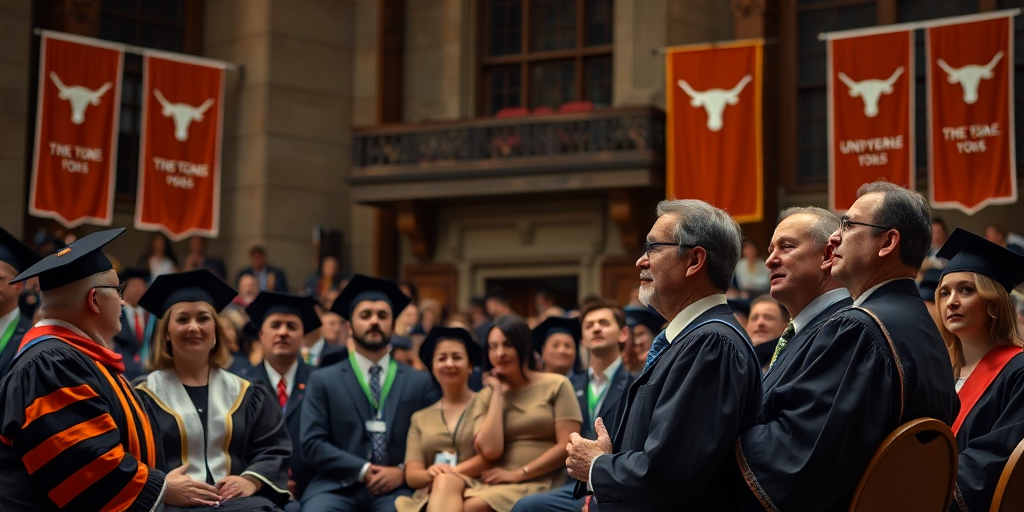**UT’s New President Emphasizes ‘Multitudes’ Over Diversity: A Community in Discussion**
As the University of Texas welcomes its new president, Jim Davis, a fresh direction hinted at in his vision has stirred conversations across the community. While Davis pledges to embrace a broad spectrum of viewpoints, strikingly absent from his vocabulary is the explicit mention of “diversity.” This omission is underscored by the recent governmental ban on Diversity, Equity, and Inclusion (DEI) initiatives in Texas public universities, raising questions about the future of UT’s inclusivity policies.
**A Retrospective on Diversity at UT**
Daniel Acosta, Jr., a former pharmacy professor at UT, recalls the university’s past as a reflection of broader societal changes during the 1960s — a period fraught with civil rights movements, the Vietnam War protests, and profound cultural shifts. As a Mexican American student in a predominantly white institution, Acosta witnessed firsthand the challenges of a campus that was, at the time, not representative of the broader Texas community.
“The lack of diversity was palpable,” Acosta mentions, reflecting on the UT atmosphere during his academic years. “We were taught not just chemistry and pharmacology but also lessons on perseverance and identity amidst societal upheaval.”
**The New Vision: Multitudes Over Diversity**
In his recent address, President Jim Davis drew on the poetic imagery of Walt Whitman, suggesting that UT should “contain multitudes,” a phrase he used to highlight values of completeness and balance. Yet, Davis’s approach seems to skirt around the issue of diversity as traditionally understood in educational contexts. His emphasis on “multitudes” suggests a place for myriad ideas but remains vague in its operational specifics, particularly concerning how these ideas translate into action within the academic framework.
University community members have noted that Davis’s proposal includes introducing courses from new initiatives like the School of Civic Leadership. However, specifics on the implementation remain sparse, leading some to question whether the changes will yield substantive developments or remain largely symbolic amid constraints on faculty governance.
**Community Perspectives: A Mixed Reception**
The omission of diversity in President Davis’s vision has sparked varied reactions. For many residents of Austin and the broader Texas community, this move is viewed as reflective of wider political currents rather than an educational stance. On the other hand, some see it as a strategic response necessitated by recent legislative changes that limit traditional diversity initiatives.
Acosta argues that genuine educational excellence requires an embracement of diverse backgrounds, not just ideational diversity. “Different experiences foster rigorous inquiry and innovation,” he asserts, underscoring his belief that such diversity cannot be effectively substituted by curricular reforms alone.
**Local Impact and Future Implications**
The local impact of Davis’s stance may echo beyond university confines, affecting community engagement and potentially influencing other educational institutions across Texas. As the university navigates this new direction, the broader Austin community remains watchful, aware that the outcomes of these policies will indelibly influence the educational landscape and local economy.
Historically, public education in Texas, including the flagship University of Texas, has played a pivotal role in shaping ideas and leadership that reflect the state’s diversity. The risk that these new directions may stall such progress is a concern for many who view diversity as vital to educational and societal advancement.
Moreover, the shift raises questions about the future of faculty involvement in university governance, an area already impacted by recent legislative changes in Texas. Without detailed faculty participation, the risk of symbolism overshadowing substantive educational advancements looms, potentially affecting academic quality.
**Balancing Innovation and Tradition**
As UT embarks on this new strategic path, striking a balance between innovation and tradition will be crucial. The community remains hopeful that the university will not only verbally acknowledge the multitudes it seeks to encompass but also actively embody them through inclusive practices and policies.
Austin residents who wish to engage in this ongoing dialogue are encouraged to participate in upcoming forums and discussions hosted by the university, aimed at gathering community input and fostering transparent communication.
**Conclusion**
The unfolding narrative at the University of Texas promises to be pivotal, determining not only the institution’s path but also, potentially, setting a precedent for public universities across the nation. As UT positions itself at this crossroads, the resonance of its decisions will likely be felt widely across the community, as residents continue to advocate for a truly comprehensive embrace of both the people and ideas that shape Texas.







